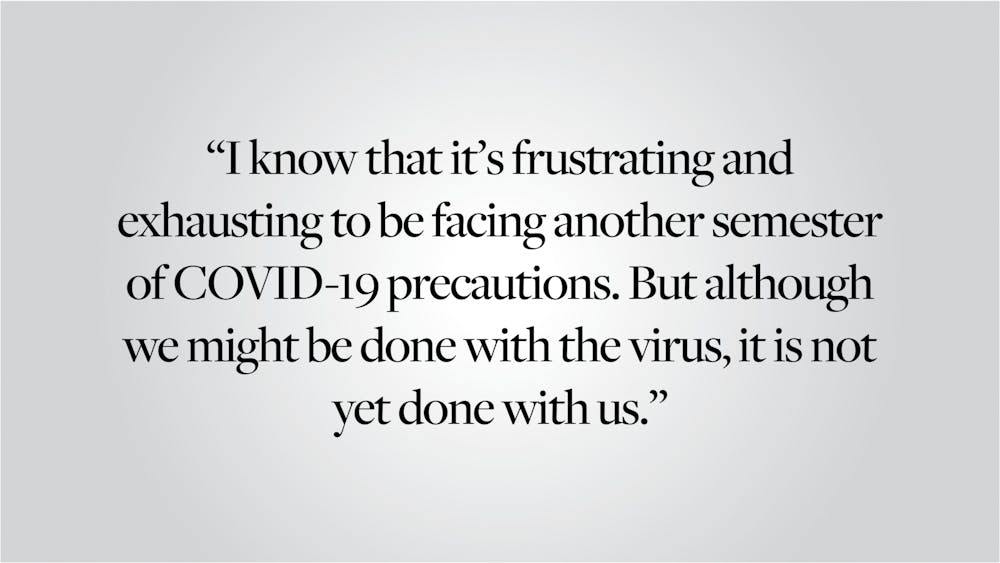Students are returning to Brown’s campus in the midst of a nationwide spike of infections with SARS-CoV-2. The volume and speed of new infections, driven largely by the Omicron variant, is greater than anything we have seen during our two years living with this virus. This variant, the arrival of which was announced just as most of us sat down to Thanksgiving dinner with friends and family, will shape the month to come in ways small and large.
It is normal to feel some fear. Fortunately, we now know that we are far better off than we were in the dark, fearful days of spring 2020, or even the disappointing summer of Delta in 2021.
As a community, Brown University is well prepared to meet Omicron with confidence. The near-universal vaccination of our staff, students and faculty with a primary series and a booster — combined with our proactive masking, ventilation and testing strategy — means that although there may be some outbreaks of cases, they will be limited; and for most of us, these infections will be quite mild.
But we can, and should, still take care. Here’s why.
The Omicron variant has some concerning characteristics. It is significantly more infectious than the Delta variant, which was itself more infectious than the original SARS-CoV-2 virus that began infecting people at the end of 2019. It has also shown the capacity to evade our preexisting immunity, infecting more vaccinated people (as well as more people who’d already been infected) than any previous variant. And because more people are getting infected, more people are getting hospitalized. It’s the simplest of statistics: a virus that is four times more transmissible, but one-fourth as dangerous, will land the same number of folks in hospital beds.
At the same time, the widely available Pfizer and Moderna vaccines do decrease the risk of symptomatic infection. More importantly, vaccines dramatically reduce the risk of severe illness or hospitalization, even from the Omicron variant — especially for those who receive boosters. As an emergency physician, I can attest that hospital beds are primarily full of the unvaccinated.
The non-pharmaceutical protective tools that we have used against the virus over the past two years — things like high quality masks and ventilation — also work to stop transmission of Omicron. Other communities’ data (and growing evidence from our own state of Rhode Island) suggests that the Omicron surge peaks and then subsides quickly. So if we can protect ourselves for the next few weeks, we will likely be out of the woods.
But not all members of our community are equally protected from Omicron. The new variant can still cause severe disease among those who are vaccinated but immunosuppressed, as well as those who are unvaccinated. And if a vaccinated person catches it, it is still possible to bring the virus home. Over the next month, therefore, regardless of our own health, we must act to slow Omicron’s spread to protect our peers — our vulnerable classmates and the faculty and staff who could infect their families.
There is also the specter of long COVID, or post-acute COVID syndrome. We at the School of Public Health are creating a consortium of researchers and best-practice through a new long COVID Initiative funded by the Hassenfeld Family Foundation. We do not yet know the true incidence or timeline of long COVID after infection with earlier variants, and we know even less about long COVID among those with breakthrough infections or among those infected with Omicron. Promisingly, there are some characteristics of Omicron that differ from Delta and earlier variants, which therefore may make it less likely to cause Long COVID. What we know clearly is that using existing tools to reduce the risk of infection is what matters.
On a practical level, then, what matters most to keep our community safe and healthy?
First, this goes without saying, but please follow the rules. Use rapid antigen tests as instructed, wear your KN95s (to protect others and yourself) and isolate if you aren’t feeling well. Secondly, look out for each other. If a friend feels sick, get them help; we have systems set up to care for those who are feeling ill. The same goes if they’re struggling emotionally. This has been a tough time for many, and we need to care for each other now more than ever. Thirdly, don’t lose hope. We are here, on campus, together. Just as we got through prior surges, we will get through this one too. Finally, think about how you can help the larger community. We at Brown are interwoven with our larger Providence and Rhode Island neighbors. This moment is a good one to think about how you can play a role in supporting those who support us.
As Ed Yong, a Pulitzer-prize winning journalist for The Atlantic, writes: Omicron “poses a far graver threat at the collective level than the individual one.” Our Brown University community has the opportunity to show the world what it looks like to responsibly navigate the evolving demands of keeping a community safe, even in the midst of a surge in infections. I am thankful for our increasing understanding of this virus and how to mitigate it successfully.
I know that it’s frustrating and exhausting to be facing another semester of COVID-19 precautions. But although we might be done with the virus, it is not yet done with us. Broad, responsible and effective use of vaccines, rapid tests and masks by our community means that we can return to life on campus, knowing that we are doing our part to keep both ourselves and our broader community as safe as possible.
Megan Ranney MPH ’10 can be reached at megan_ranney@brown.edu. Please send responses to this opinion to letters@browndailyherald.com and other op-eds to opinions@browndailyherald.com.





